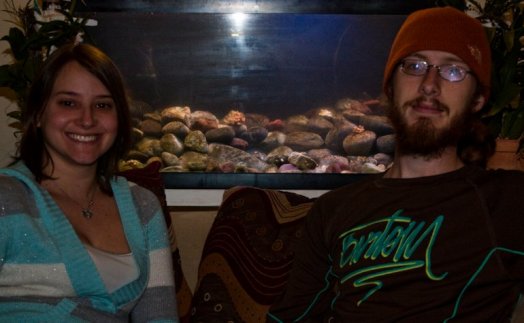
|
|
|
Congratulations Amber and Daniel, on being selected tank of the month. |
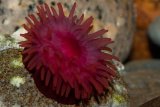
|
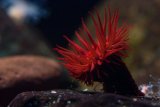
|
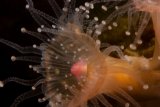
|
About the Tank
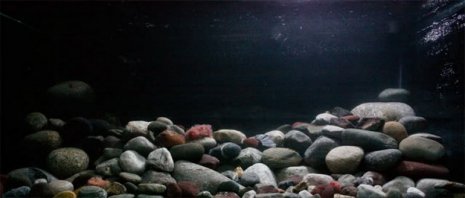
Experience in hobby
Q How long have you been doing this?
A We got into the hobby in college about 6 years ago. We started off with nano reef tanks, usually focusing on just a couple of species. The success of these tanks was highly variable, due to the nature of living in a college dorm requiring the tank be moved many times a year. After moving from Kentucky to Maryland a couple of years ago, we began to explore biotope/species aquariums, with an interest in unique species and tank ideas. The first of these was a Singapore lagoon biotope centered around the mini carpet anemone (Stichodactyla tapetum). The system was limited to species found in the coastal waters of Singapore, while also serving as a propagation system for mini carpets. At its peak, we were maintaining approximately 100 mini carpets and 40 “maxi" mini carpets in a 30 gallon system. Later, our interest turned towards temperate aquariums as a unique spin on marine tanks when we came across several beadlet anemones (Actinia equina) in the holding tanks of a local wholesaler.
Q Who got you into the hobby?
A We've both been fascinated with the tropics and with pets of all sorts since we were kids. The hobby was a natural choice for us when we ended up in dorms and the only allowed pets were fish. Walking into the LFS that first time and seeing a huge revolving cylinder reef tank made up our minds that a betta was not going to be a sufficient pet.
Q Who in the hobby most influences you?
A For this tank, in particular, Steve Weast was a huge influence. As one of the first, and best known, to successfully maintain a temperate aquarium, his information has been of great use. Secondly, Jeremai and Jamie, and others, on the Nano-reef forum deserve special credit for expanding the bank of knowledge for keeping small temperate marine aquariums. Temperate reef-keeping is very much in its infancy right now, and the techniques used are still based on trial and error. Without the input of ideas and collective attempts at temperate aquarium-keeping from the nano-reef group, we'd likely have given up on this project before we started.
Tank setup and equipment
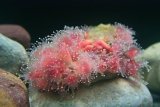
The tank is a 40-gallon breeder-style AGA. Temperature control is provided by a 1/5 hp Custom Sea Life chiller and temperature controller via a closed loop run by a QuietOne 2200. Additional circulation is provided by a Hydor Koralia 2. The tank is wrapped on back, sides, and bottom with Styrofoam insulation and pvc pipes are wrapped with fiberglass insulation to reduce the strain on the chiller and prevent condensation on hard-to-reach areas.
This aquarium is a temperate marine biotope. The temperature is maintained at 58*F - temperatures similar to the coasts of New England and the west coast of the United States. The substrate is composed of quartz and granite cobbles that we collected from the beaches of Maine instead of the standard sand bottom in order to simulate the natural habitat more accurately.
The tank began as a simple ten gallon setup in order to maintain a small group of beadlet anemones (Actinia equina) that we found in the tropical systems at Roozen's. We decided to use these as a starting point to a temperate aquarium, and spent the next six months dropping the temperature from 80*F to 58*F in order to avoid temperature shock. During a move, we upgraded the tank to the current 40 gallons and slowly added the strawberry anemones (Corynactis californica), more beadlet anemones, and a couple of unknown anemone species.
Q What is your maintenance schedule like?
A
We feed the tank as we remember - every other day is ideal.
Water changes occur whenever the anemones begin to look unhappy - on average 30%-50% of the tank volume once a month.
Due to the low temperatures, we only have to top off with fresh water once every 2-3 months (without an ATO!).
Glass scraping is required once every 2-3 months to remove some of the filamentous algae.
The best part of this system is the lack of required maintenance. The cold temperatures slow down everything in the tank - metabolic rates of all species are slow, evaporation is slow. We would be comfortable leaving this system alone for a month with only the need for food.
Q How much time do you spend weekly?
A On average, less than 5 minutes a week, but much more simply staring at the anemones swaying in the current.
Q Where do you keep your water parameters?
A Temperature is 58*F. The specific gravity of the salt water added to the tank is 1.025. Beyond that, we haven't checked in over a year. Since the only other parameters of concern in this system are ammonia/nitrite/nitrate, we can simply look at the anemones for signs of stress if a parameter is off.
Q What brand salt do you use?
A Instant Ocean.
Q What do you feed your fish and or corals?
A Frozen mysis for the larger anemones, frozen cyclopeeze for the strawberry anemones
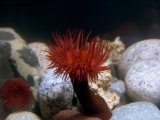
Q How do you maintain calcium/alkalinity?
A Only through water changes. It isn't necessary in this system since the only inhabitants that utilize them are the spirorbid feather dusters that managed to survive the initial temperature drop.
Q Do you dose anything? If so, how much, how often?
A Nope!
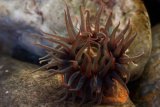
Q What type of lighting do you have and what scheulde do you have them on?
A
Lighting isn't necessary for the tank - none of the inhabitants are photosynthetic. We use your standard floor lamp with some cool white compact fluorescent lights, simply for viewing purposes next to the aquarium. The strawberry anemones, in particular, prefer subdued lighting. We originally added a T5 fixture for aesthetics, but the strawberry anemones refused to open in the bright light.
The lights are on if we're in the room, off when we leave.
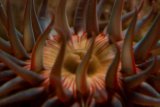
Q What kind of water flow do you have? How do you accomplish it?
A Approximately 1140gph (28x turnover rate). 540gph through a QuietOne 2200 on a closed loop moving water through the chiller. 600gph through a Koralia 2.
Q What are your future plans for improvement/upgrade of the tank?
A This tank is really just beginning - firstly, the addition of a skimmer to the closed loop will allow us to add more livestock without a substantial increase in our maintenance. Once that is accomplished, we intend to collect from the coast of New England this summer and add some species native to the Pacific Northwest in the fall. The Koralia will be replaced by a Vortech to create better flow patterns and obstruct the view less, and the glass tank will be replaced by a custom acrylic tank with sides thick enough to reduce condensation.
Q What makes your setup special or unique?
A
The most unique part of the tank is the temperature. The temperature really affects every other aspect of the tank - from the inhabitants to the maintenance. Many of the species that will be added to this tank in the coming year are species that were, in just the past few years, only seen in public aquaria.
The temperature really plays an important role in maintenance: evaporation is no longer an issue of concern and time really slows down. Whereas in the tropical tank where the nitrogen cycle may be complete in a week to a month, the diatom bloom that accompanies the ending stages of the cycle in this tank took six months. Filamentous algae didn't begin to show up until nearly a year into the life of the tank, and grows extremely slowly.
Additionally, the organisms in temperate regions are usually non-photosynthetic. The expense of the chiller is offset by the lack of need for expensive and powerful lighting.
Q If you had to start from scratch, would you do anything different?
A While we would stick to glass aquariums for everything else, a really thick acrylic tank would be a better choice for this one to reduce condensation in the summer. Otherwise, we've enjoyed how the tank is turning out. Because things take so much longer to settle down in temperate aquariums, we've really had time to plan out each tank addition and step towards improving the design.
Q Do you have any advice for those folks whom are new to the hobby.
A Patience…in everything aquarium related. It seems like the most common reason for aquarium disasters is a lack of patience. This is something we didn't really understand that well until this tank came along, but it is the most important key to success in this hobby. And research…learn everything you can about the organisms you're caring for and the conditions they prefer. The more you know, the better your chances of success.
Personal
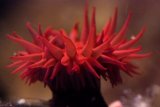
Q What are your other hobbies?
A We enjoy orchid collecting (a good way to utilize that extra humidity from all the fish tanks). Amber enjoys reading and Daniel does photography.
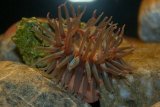
Q Who would you most like to meet past present or future?
A Amber would like to meet Eleanor Roosevelt, since she was such an inspirational leader. Daniel would like to spend a day in the life of Israel Kamakawiwo'ole, Hawaiian singer.
Q What is the last book you read?
A Daniel just finished Pirate Latitudes, by Michael Crichton. Amber finished five books while doing this interview…
Q Why did you choose the screen name you did?
A It was the combination of our initials (before we got married) for an instant messenger screen name that we used to talk to each other in college. Somehow, it stuck...even though no one gets it right.
Q Scotch or burbon?
A As good Kentuckians, we must vote bourbon. Coke would really be better, though.
Q Things I wish I knew 6 years ago:
A How much time, energy, and money would be spent on this hobby.
Q Which fish are your favorites?
A Ah, how we wish we had one. Unfortunately, the cheap ones are still out of our price range for now. Until the temperate aquariums gain popularity, very little collection is done for these systems, except for hobbyists collecting their own livestock. We are hoping to catch some suitable aquarium fish this summer for ourselves in New England - gobies or lumpsuckers would be splendid catches.
Q Which corals are your favorites?
A Our only corals are the two hundred or so strawberry anemones (Corynactis californica), which are actually a type of mushroom-type soft coral. They'll be our favorites no matter what else we add to the system due to their bright pink and orange colors with white ball-like tips that colonize everything. They make for a beautiful display in public aquariums, and we're hoping that the tank slowly fills with them.
Q Which inverts are your favorites?
A
We currently have two species of true anemones. The first is the beadlet anemone (Actinia equina), a species that ranges across the west coast of Africa and Europe. These were the anemones that jumpstarted the tank, and they're neat because they'll go in a tropical tank or a temperate tank and be happy. They're also brooding anemones - baby anemones split off from inside the gut cavity of the anemone and get spit out after they reach a sufficient size to fend for themselves. Thus far, we've had two brooding events. Our beadlets are red in color, with small blue beads between the tentacles.
The second species is an unknown species from Africa. We believe it to be in either the genus Phymanthus or the genus Phymactis. We obtained these from Diver's Den, mislabeled as beadlet anemones. These are neat because they tend to have striped tentacles and oral disk, and the column has a bumpy, two-toned color.
We also have a number of Spirorbid feather dusters. In a tropical tank, these probably wouldn't receive much attention, but these managed to hitchhike on a rock from the initial batch of beadlet anemones from Roozen's, and were able to survive the huge temperature drop.
In the future, we would like to add several species of anemones, including the plumose and rose anemones common along the Pacific Northwest coast.
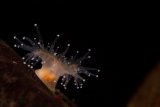 |
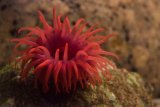 |
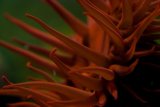 |
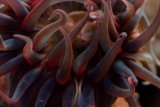 |
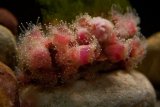 |
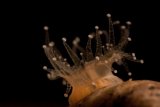 |





